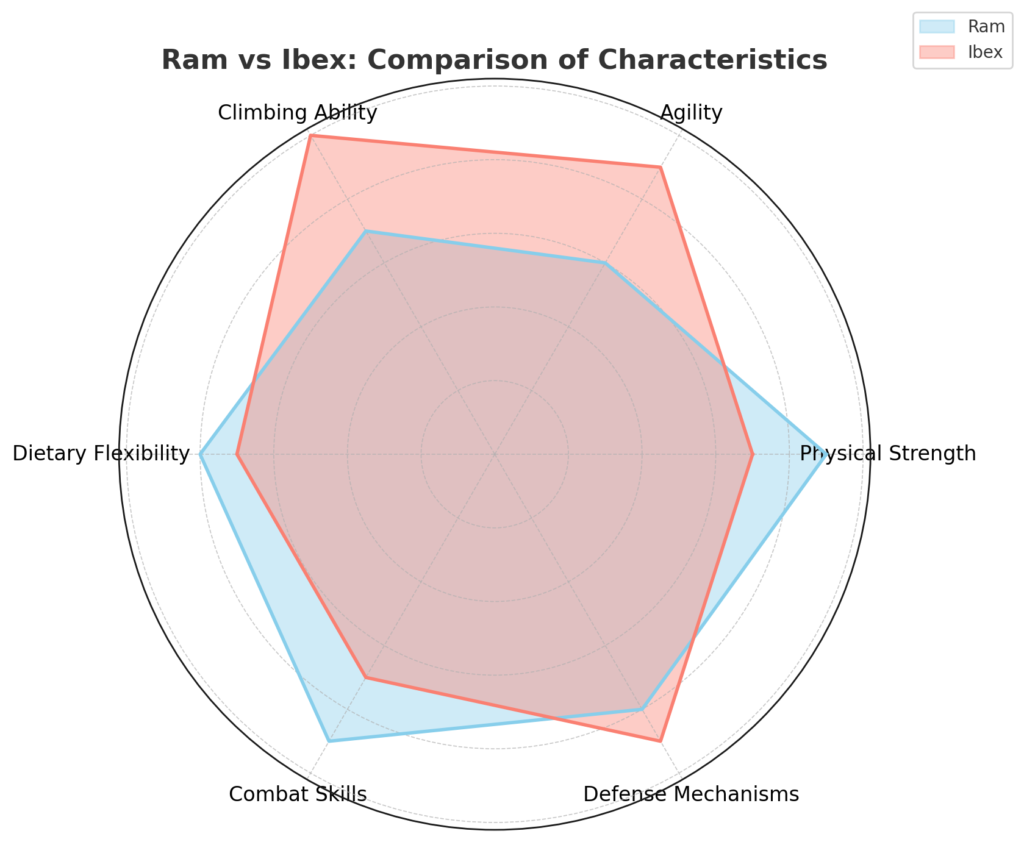When it comes to mastering rugged mountain terrain, ram vs ibex is a fascinating matchup. Both the ram (bighorn sheep) and the ibex (Alpine ibex) are remarkable climbers, boasting specialized adaptations and impressive physical prowess. One thinks of the question: Ram vs Ibex Who Would Win? If these two mountain dwellers were to go head-to-head, who would win? This comparison explores their habitats, adaptations, combat skills, diets, defense mechanisms, and ecological roles to determine which of these mountain masters would come out on top.
1. Overview: Ram vs. Ibex

To truly understand the ram vs ibex comparison, it helps to look at each animal individually. Both the bighorn sheep and Alpine ibex are well-known for their ability to navigate steep terrains, but they possess different characteristics and behaviors that set them apart.
1.1 The Ram (Bighorn Sheep)
The bighorn sheep, commonly found in North America, is named for its impressive, curling horns. Male bighorns, known as rams, can weigh up to 300 pounds and stand around 3 feet tall at the shoulder. Their horns, which can weigh up to 30 pounds, are used both for protection and as weapons in battles over territory and mating rights. Known for their strength and endurance, bighorn sheep are adapted to the rocky terrains of mountains and can leap as far as 20 feet in a single bound.
1.2 The Ibex (Alpine Ibex)
The Alpine ibex is a species of wild goat native to the European Alps. Males, called bucks, weigh between 150 to 260 pounds and are distinguished by their long, curved horns, which can grow up to 40 inches. Ibex are agile climbers, often seen scaling near-vertical cliffs with ease. Their hooves have a special split design that provides incredible grip on rocky surfaces, making them highly skilled at navigating treacherous terrain. The ibex is slightly smaller than the ram but equally formidable in strength and adaptability.
2. Habitat and Adaptations: Ram vs. Ibex
Both the ram and ibex have adapted to survive and thrive in mountainous environments, but they inhabit different regions with unique challenges.
2.1 Ram Habitat and Adaptations
Bighorn sheep are primarily found in the mountainous regions of North America, from Canada to Mexico. Their habitats include rugged cliffs, canyons, and steep slopes. Bighorn sheep have a highly developed sense of balance and powerful muscles that allow them to climb efficiently. Their thick coats provide insulation against cold mountain temperatures, while their large lungs and heart enable them to function at high altitudes where oxygen levels are low.
2.2 Ibex Habitat and Adaptations
The Alpine ibex resides in the European Alps, where it navigates steep mountain ranges and sheer cliffs. Ibex have evolved hooves with a split design, allowing them to grip narrow ledges and rocky surfaces. These animals are known for their exceptional climbing abilities and often venture into near-vertical terrain to avoid predators. The Alpine ibex also has a dense winter coat to protect against the cold and is highly efficient in foraging for vegetation even in sparse mountain landscapes.
3. Physical Strength and Combat Skills: Ram vs Ibex Who Would Win?
Physical strength and combat prowess are central to the ram vs ibex debate. Both animals have developed unique fighting techniques suited to their environments.
3.1 Ram Combat and Physical Strength
Rams are known for their intense head-butting contests, where two males will charge at each other and collide horns with tremendous force. These battles, often seen during the mating season, can last for hours and require endurance, skill, and strength. The bighorn sheep’s skull structure is adapted to withstand these impacts, with a double-layered, thick skull that absorbs shock. Rams are powerful animals, capable of delivering forceful blows that could seriously injure an opponent.
3.2 Ibex Combat and Physical Strength
The ibex also uses its horns in combat, though its fighting style is different from that of the ram. Instead of direct head-butting, ibex engage in a sort of pushing and shoving contest, where they use their long, curved horns to lock with opponents. This tactic requires balance and skill, as they often duel on steep slopes. The ibex’s horns, while not as dense as the ram’s, are longer and used more strategically to gain leverage in battles. Although they don’t generate as much impact, ibex possess remarkable stamina, which serves them well in long, drawn-out fights.
4. Diet and Foraging: Ram vs. Ibex
In their mountainous habitats, both the ram and ibex have developed specialized foraging behaviors to meet their dietary needs.
4.1 Ram Diet and Foraging Behavior
Bighorn sheep are herbivores with a diet consisting primarily of grasses, shrubs, and herbs. During the summer months, they feed on lush vegetation found at higher altitudes, while in winter, they move to lower elevations to graze on shrubs and dried grasses. Rams have a unique digestive system that allows them to extract nutrients from tough plant material, giving them a competitive advantage in mountainous areas with sparse vegetation.
4.2 Ibex Diet and Foraging Behavior
The ibex diet is similar to that of the ram, focusing on grasses, herbs, and shrubs. However, ibex are more agile climbers, allowing them to reach vegetation in seemingly inaccessible areas. They are also known to forage on lichen and moss growing on rocks. This ability to access food in challenging terrain gives ibex an edge in regions with limited resources, especially during winter when they move to higher elevations to avoid snow-covered lower slopes.
5. Predators and Defense Mechanisms: Ram vs. Ibex
Both the ram and ibex have natural predators and have developed strategies to defend themselves in their high-altitude habitats.
5.1 Ram Predators and Defense
Bighorn sheep are preyed upon by cougars, wolves, and occasionally, bears. Their primary defense is their agility and ability to navigate steep terrain quickly. When threatened, rams often retreat to high, rugged cliffs that are difficult for predators to access. In addition, their horns provide a formidable defense against smaller predators. Rams are highly social and live in groups, which provides additional protection by keeping watch for danger.
5.2 Ibex Predators and Defense
The main predators of the Alpine ibex are wolves and golden eagles, the latter targeting young ibex. To evade predators, ibex rely on their climbing abilities, often scaling cliffs and ledges that are nearly vertical. Their sure-footedness allows them to reach places where few predators can follow. Ibex also tend to form herds, which enhances their ability to detect and evade threats. Their horns are more of a deterrent than an active defense, but they can use them effectively if cornered.
6. Ecological Roles: Ram vs. Ibex
The presence of both rams and ibex contributes to the health and balance of their ecosystems.
6.1 Ram Ecological Role
Bighorn sheep play a significant role in their ecosystem by grazing on vegetation, which helps control plant growth and maintain the balance of flora in their habitat. Their foraging also promotes new plant growth, and their droppings enrich the soil, fostering nutrient cycling. By maintaining vegetation levels, rams indirectly support other species, such as smaller herbivores, which benefit from the availability of resources.
6.2 Ibex Ecological Role
Ibex have a similar ecological role, contributing to vegetation management in their alpine habitats. Their grazing habits prevent overgrowth and support plant diversity, as they consume various grasses and herbs. Additionally, by feeding in high-elevation areas, they help stabilize soils and reduce erosion, which is crucial in mountainous regions. The presence of ibex also supports predators like wolves, contributing to a balanced ecosystem.
7. Conclusion: Ram vs Ibex Who Would Win?
In a direct showdown, the ram vs ibex who would win the question remains complex. Rams have the advantage of brute strength, with a head-butting style that delivers powerful impacts. On the other hand, the ibex boasts exceptional agility and the ability to climb away from potential threats. While a physical confrontation might favor the ram, the ibex’s adaptability and climbing skills give it an edge in evasion. Ultimately, both animals are exceptionally suited to their environments, with unique adaptations that make each a “mountain master” in its own right.







